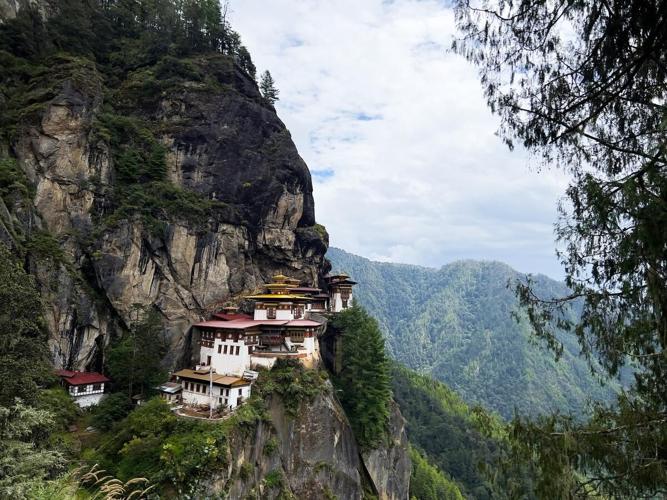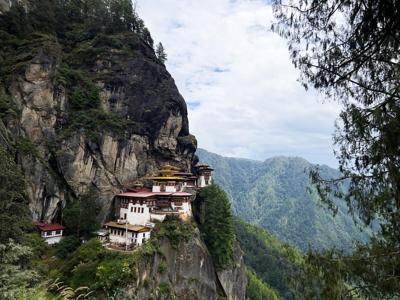According to Bhutanese folklore, the garps of ancient history ŌĆö messengers entrusted with ferrying secret notes between fortresses ŌĆö ran like the wind through these enchanted forests. As our group hikes a slender woodland path near the capital city of Thimphu, my boots clomp at a far less breezy pace, my ║ŻĮŪ╔ńŪ°╣┘═°lungs unaccustomed to the Himalayan air.
IŌĆÖm gingerly navigating the slippery descents when our jaunty G Adventures guide, Dorji Bidha, magically appears with a gift: a ŌĆ£trekking poleŌĆØ fashioned out of a sturdy branch, its bark sliced off for a smooth handle.
ŌĆ£I saw a few men in front of me and requested of one, ŌĆśAzho (uncle), can you please make walking poles for my guests ŌĆö and make them fast?ŌĆÖŌĆØ she tells me. The kindly man drew his knife and obliged. Only then did Bidha notice who sheŌĆÖd tasked, with a flush of embarrassment: ŌĆ£I realized it was his excellency, our minister of agriculture!ŌĆØ
ItŌĆÖs an endearing anecdote, and one that reflects BhutanŌĆÖs prevailing attitude: Here, itŌĆÖs everyoneŌĆÖs job to warmly welcome guests.

Paro Taktsang, in the distance, seems to cling to a cliff about 800 metres above a valley.
Wing Sze TangItŌĆÖs late September, and IŌĆÖve arrived in Bhutan with Toronto-based tour operator , as part of an international crew of journalists invited to follow in the fabled footsteps of the garps. And this morning, after a royal ribbon-cutting at the sacred fortress Semtokha Dzong, weŌĆÖve taken to the woods ŌĆö trailing behind the spry prime minister, Dr. Lotay Tshering, whoŌĆÖs leading the way alongside a nimble entourage of red-robed Buddhist monks.
WeŌĆÖre here for a historic moment: IŌĆÖve landed just after Bhutan lifted its pandemic border closure, and all of this pomp is for the official inauguration of the . The initiative is a big deal, envisioned as both a new tourism draw and a national unity project, connecting communities across the country. If measured by buzz alone, the trail is already a success, landing on TimeŌĆÖs list of ŌĆ£WorldŌĆÖs Greatest Places 2022.ŌĆØ
The trail is the revival of an ancient zhung lam, a circa-16th-century pilgrimage route across the countryŌĆÖs middle, once frequented by monarchs, religious leaders, traders and travellers of all types. Ages ago, it was the only way to get across the tiny landlocked nation wedged between China (Tibet) and India. But with the advent of a highway in the 1960s, the footpath fell out of favour. While some sections remained useful for activities like cattle herding, the trail was, by and large, lost to time.
The ambition to restore the Trans Bhutan Trail dates back to 2019, and thereŌĆÖs a Canadian connection: The effort has been led by the and its partners, with the backing of the King of Bhutan, Jigme Khesar Namgyel Wangchuck. The non-profit foundation chose G Adventures, known for its culturally immersive and community-conscious tours, as the trailŌĆÖs launch partner.

Signage on the Trans Bhutan Trail. The path revives an ancient pilgrimage route.
Wing Sze TangTrail surveying began in earnest in 2020, guided by elders and the remnants of chortens (religious monuments) that once signalled the way. Next came the restoration work, which called for clearing a passage through thickets, rebuilding 18 bridges, adding roughly 10,000 stone steps, and adding markers (simple slashes of white on trees and stones).
Today, the west-to-east path stretches 403 kilometres, spanning Haa to Trashigang, across wide-ranging terrain. We test our legs on just fractions of it ŌĆö an end-to-end tour would take roughly a month.
But our exploration is enough to get acquainted with the quad-taxing downhills and cardio-testing climbs; rainforests moody with mist, moss and mystery (where itŌĆÖs easy to imagine why old tales of demoness hauntings abounded); and sweeping alpine meadows flecked with delicate wildflowers and flanked by mountains. After hours of sweaty walking, weŌĆÖre regularly rewarded with views of wide-open fields in gradations of green, terraced rice paddies, and hillsides dotted with rammed-earth houses.
The trail also crosses a dozen mountain passes, two national parks (Jigme Dorji and Phrumsengla), nine dzongkhags (districts) and 27 gewogs (villages) ŌĆö including more remote and rural areas where few travellers go.
ŌĆ£We didnŌĆÖt do this to build a tourist trail,ŌĆØ Sam Blyth, founder of the Bhutan Canada Foundation, explains at a small media get-together in Thimphu. ŌĆ£We wanted to use the trail as a means of community development.ŌĆØ He first came to Bhutan in 1988, with Pierre Elliott Trudeau as his expedition buddy, and promptly fell in love with the country, inspiring his philanthropic interest in it.
Each of the trailŌĆÖs 28 sections will have a local guide, Blyth adds, and each gewog will take ownership of their respective section. The villages will draw in trekkers with food, accommodations (like homestays at traditional farmhouses) and souvenirs, which will help spread needed tourist dollars into hitherto unvisited places.
BhutanŌĆÖs approach to tourism has long made the country an anomaly on the global scene. It didnŌĆÖt begin welcoming foreigners until 1974, and since then, its tourism motto has been ŌĆ£high value, low volume.ŌĆØ That meant ensuring travellers wouldnŌĆÖt overwhelm what nature or the small nation could handle. In 2019, visitor arrivals numbered just about 316,000, according to the Tourism Council of Bhutan.
In June, the government announced a major (and controversial) change: It raised the amount of a tourist tax, called the Sustainable Development Fee, up to $200 (U.S.) per person, per night.

Writer Wing Sze Tang in an alpine meadow on the Trans Bhutan Trail.
Wing Sze TangHow many travellers will balk at the hefty sum remains to be seen, but itŌĆÖs contributing to the perception of Bhutan as a developing nation thatŌĆÖs also surprisingly expensive and exclusive. Still, in an age of rampant overtourism, itŌĆÖs refreshing to see a country choose the path less trampled.
The fee is meant to funnel investment to good causes, including sustainability, infrastructure and youth programs, as well as help fund the countryŌĆÖs free-for-all health care and education. Protective of its lush land, which has more than 70 per cent forest cover, Bhutan is one of the rare places on Earth that can brag about being carbon-negative.
On our last day, we set out for the countryŌĆÖs most iconic sight: Paro Taktsang, also known as the TigerŌĆÖs Nest monastery, in the upper Paro Valley. While itŌĆÖs not a part of the Trans Bhutan Trail, many guided itineraries here, including the , include it as an essential stop.
ItŌĆÖs an architectural feat thatŌĆÖs even more astounding in person than in pictures ŌĆö I canŌĆÖt grasp how itŌĆÖs been built on the side of a cliff, about 800 metres above the valley. Reaching it requires a nearly all-uphill hike for around four kilometres, passing century-old oak trees and strung-out prayer flags. In this deeply spiritual country, itŌĆÖs believed the colourful cloths will carry blessings with each flutter.
Although the path to the monastery is well worn, today weŌĆÖre sharing it with just a few horses, donkeys and scant other travellers. I have no doubt that before long, the tourists will return. Not the masses, but the ones whoŌĆÖll care, drawn by the allure of a destination nicknamed ŌĆ£the last Shangri-LaŌĆØ for its pristine beauty and devotion to going its own way.
Wing Sze Tang travelled as a guest of G Adventures and the Trans Bhutan Trail, which did not review or approve this article.

























To join the conversation set a first and last name in your user profile.
Sign in or register for free to join the Conversation